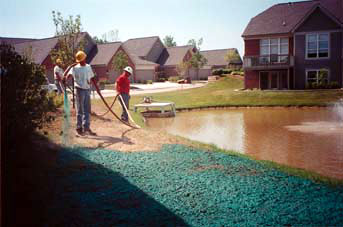The Evolution of Hydromulchingby Steve R. Zwilling, Conwed Fibers |
 During the post WWII era, the country looked inward to build the infrastructure needed to service the rapid growth of the nation. Residential and commercial building was growing at an unprecedented pace and the urban sprawl was born. Government investment to develop a transportation system to support the growth became a top priority among legislatures. As highway systems were being built across the nation, the need for more effective methods for revegetating the scarred landscape became essential. Then, in 1953, Charles Finn of the Finn Equipment Company, developed the first commercially successful HyroSeeder. It mechanically mixed seed, fertilizer, and lime with water, producing a slurry mixture, which was then applied to the seedbed. As the market grew, companies such as Reinco, Inc., and Bowie Industries, Inc. developed equipment that could effectively pump, spray and distribute large volumes of water and seed on disturbed landscapes. In the late 1950's, International Paper introduced a mulching material made from natural cellulose fibers to provide a one-step mulching process that worked better than the water-only system. The custom blend of hydraulic mulch, seed and fertilizer was called a "homogeneous slurry" and could be applied by hydraulic seeding equipment to a wide range of project types. International paper soon withdrew from the market so Weyerhaeuser and Conwed Corporation stepped in to fill the void. Conwed Corporation and Weyer-haeuser commercialized the process of Thermo-mechanical defibration of wood fiber, in the early 1960's. Both companies became the dominant manufacturers in the industry, providing the seeding contractor with a top performing wood fiber mulching material that not only assisted plant establishment, but helped control erosion. The popularity of hydromulching grew at a rapid pace in the 1970's and 1980's when equipment manufacturers developed smaller machines targeting contractors that focused on residential, commercial and fine turf projects. The flexible technology allowed the seeding contractor to custom blend seed, fertilizer and mulch to establish a wide range of plant material at an economical cost. As the industry grew so did the number of suppliers of hydraulic seeding equipment and hydraulic mulch. Advancements were made both with materials and equipment to insure contractor success. In the later 1970's, Conwed Corporation received a process patent for incorporating guar tackifier with wood fiber that significantly improved the fiber's ability to control erosion. Other manufacturers also blended and marketed a host of tacking agents, which improved seeding success. During the same time period, warm season grass sprigs were incorporated with wood fiber mulch to produce a vegetative planting system called hydro-sprigging. Today, Hydro-Sprigging has been used on hundreds of golf courses as an effective way to quickly establish premium hybrid Bermuda grasses on expansive fairways. Today's hydraulic seeding equipment can pump a broader range of materials reliably and cost effectively. Due to the proliferation of hydromulching projects nationwide, awareness of the process has trickled down to the consumer level. Most homeowners, when asked, are aware of the technology be referring to hydromulching as "that green stuff that they spray along the roadside". International awareness has also increased and US based machine and hydraulic mulch manufacturers export multiple seeding units and thousands of tons of fiber all over the world. One of the largest international projects using wood fiber mulch was at the Hong Kong Airport project in 1997 and 1998, which consumed multiple containers of virgin wood fiber with guar tackifier. The hydromulching project was effective, completed on time and within budget. Other vegetative methods that compete with hydromulching include direct seeding, sodding, and manual or mechanical sprigging. Each of these methods has always been somewhat easy for the hydromulching contractor to compete with because hydromulching is a cost-effective way to control erosion, custom vegetate an area and can usually save developers time and money. Shortfalls of this seeding method are due to the use of substandard seeds, mulching material and/or application rates that fall short of manufacturers recommendations. Other factors that can effect success is the amount of available water and soil preparation which is always a factor when establishing plant material. Today's hydromulching contractor has distinct advantages over the pioneers of the industry. Advances in seed research, equipment and mulching materials help contractors better meet the demands of their client. New product technologies like bonded fiber matrix products gives the hydromulching contractors a broader arsenal of tools to combat erosion. Chemically bonded fiber matrix products have the potential to revolutionize the seeding industry be bridging the gap between current hydraulic mulching products and other temporary erosion products. Introduced in 1994, bonded fiber matrix products can be hydraulically applied saving both time and labor while successfully securing some of the most challenging erosion sites. This niche product is ideal for area where vegetation is the primary long term erosion medium. Chemically bonded fiber matrix product must be applied in dry conditions to be effective and is now available from leading hydraulic mulch manufactures. Hydraulic seeding is a proven technology that has met the needs of contractors and developers for over forty years. The wide range of equipment, materials and contractors, warrants the consumer to ask key questions prior to accepting a seeding bid.
The hydromulching industry continues to thrive as hundreds of new machines are purchased every year by innovative contractors. This forty-year-old technology, which is still considered new, is sure to evolve and thrive well into the new millennium. L&W For more information, contact Steve R. Zwilling, Conwed Fibers, 1002 Bucks Industrial Park, Statesville, NC 28625, (704)871-8500, fax (704)871-8740. |
©2000, 1999, 1998 Land and Water, Inc.